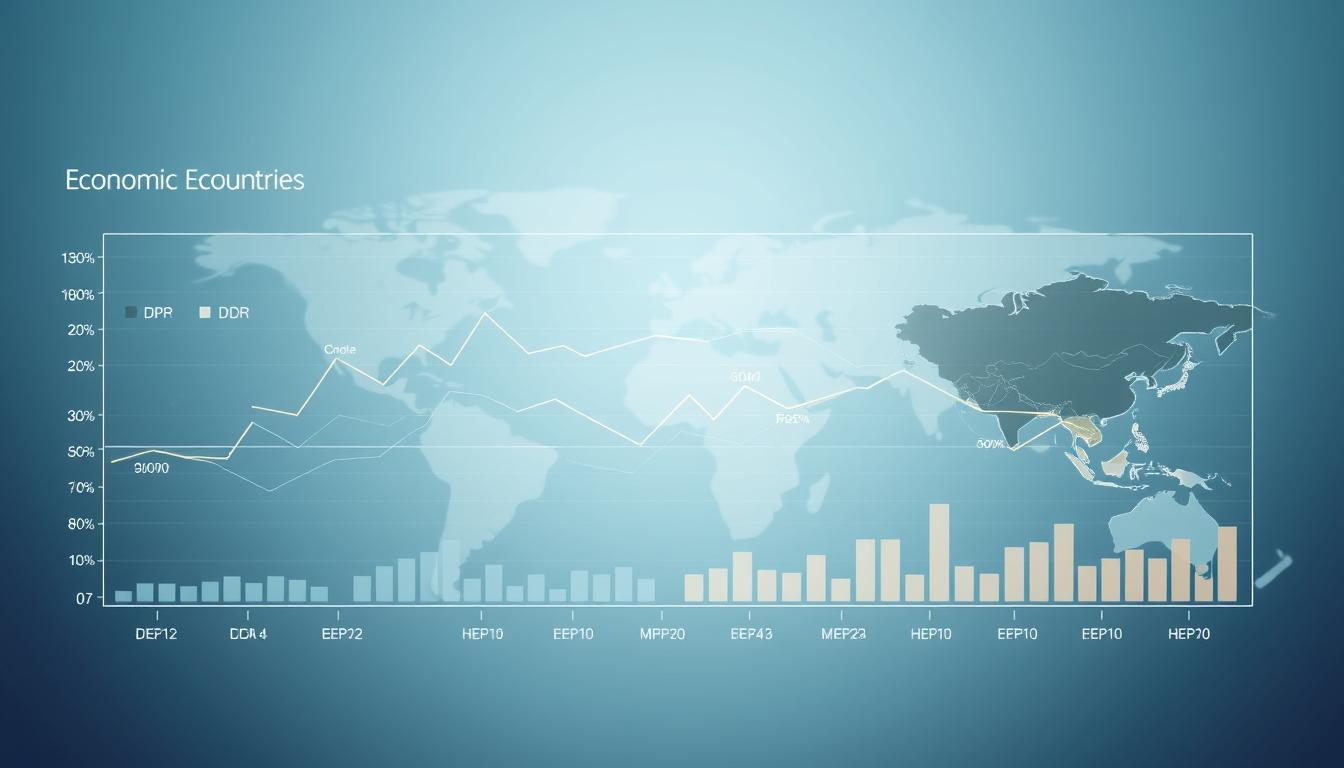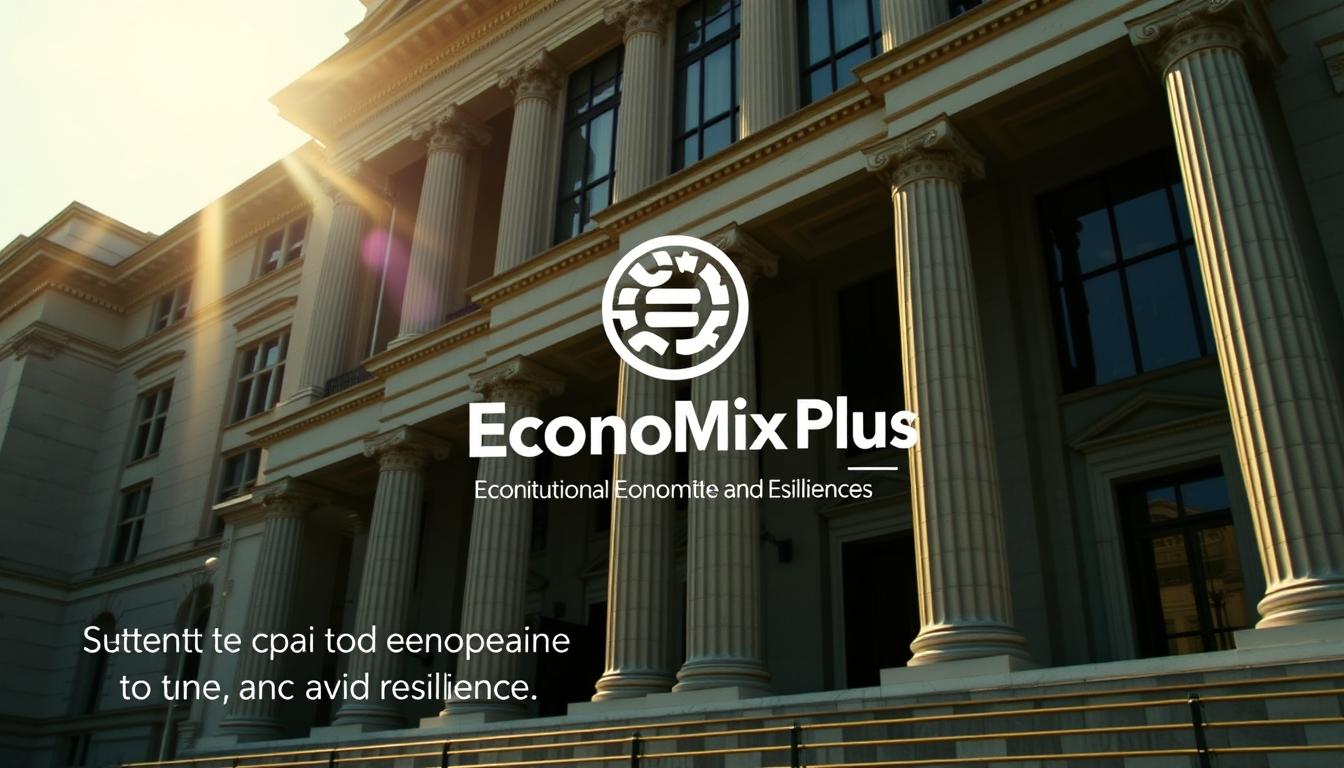Can a country’s economic success be just about how fast it grows? The answer is not simple. Some European economies with slower growth rates are actually doing better than those that grow faster.
The economic growth rate in Europe changes a lot from country to country. Some grow quickly, while others move at a slower pace. But when we look at how well a country is doing overall, the ranking criteria often give the edge to the slower growers.
This situation makes us wonder what really makes a country economically successful. Is it just about the GDP, or are there other economic development signs at work?
Key Takeaways
- The economic performance of European countries is not solely determined by their growth rate.
- Slower-growing economies often outperform faster-growing ones in terms of overall economic development.
- The ranking criteria for economic performance consider multiple factors beyond GDP.
- European countries with strong economic development indicators tend to outrank those with faster growth rates.
- The relationship between economic growth rate and overall economic performance is complex.
The European Economic Paradox
In the global economy, European countries often surprise us. They get high rankings even with slow growth. This makes us wonder what else matters for economic success.
Defining the Growth-Ranking Disconnect
There are many reasons for the gap between growth and ranking. GDP growth is important, but it’s not everything. Quality of life, innovation, and strong institutions also count a lot.
Statistical Overview of European Growth Rates
European countries have had different GDP growth rates over time. For example, Vietnam’s growth rate is high, but it’s not as high in the economic rankings as some European countries.
GDP Growth Comparisons: Europe vs. Emerging Markets
European countries grow slower than emerging markets. But, they often rank higher in the economy. This shows how complex economic rankings can be.
Historical Growth Trends (2000-Present)
Looking at growth from 2000 to now, European economies have had ups and downs. Some years were slow, others were moderate. Yet, many European countries keep their high rankings.
Understanding Economic Rankings: Beyond GDP Growth
There are many ways to look at a country’s economy, not just GDP growth. These methods give a detailed view of a country’s economic health. They show what a country does well and what it needs to work on.
Major Global Economic Ranking Systems
Many big organizations publish rankings that look beyond GDP. These include:
- The World Economic Forum’s Competitiveness Index
- The IMF and World Bank’s various economic measurements
World Economic Forum Competitiveness Index
The World Economic Forum’s Index looks at institutional strength, innovation capacity, and market efficiency. It shows how well a country can keep growing its economy and boost productivity.
IMF and World Bank Measurements
The IMF and World Bank use GDP per capita, human capital, and infrastructure quality to judge economies. These metrics help understand a country’s economic stability and growth chances.
Criteria Used in Economic Performance Evaluation
Assessing a country’s economy involves numbers and qualities. Numbers like GDP growth and job rates are important. Qualities like the business environment and innovation are also key.
Quantitative vs. Qualitative Indicators
Using both numbers and qualities gives a clearer view of a country’s economy. For example, a country with high GDP but a bad business climate might not be as strong as one with lower growth but a good business environment.

The Maturity Factor: Developed vs. Developing Economies
Understanding the difference between developed and developing economies is key. Developed economies have high GDP per capita and advanced infrastructure. They grow differently than developing economies.
Growth Patterns in Mature Economies
Mature economies grow slower because of their strong market structures. Growth trends in developed economies are shaped by tech, service growth, and innovation.
The S-Curve of Economic Development
The S-curve shows how economies grow fast at first, then slow down. This is seen in many European countries. Their growth came from industrialization and tech progress.
The Law of Diminishing Returns in Economic Development
The law of diminishing returns says more investment in a sector leads to less growth. This is true for advanced economies, where growth is hard.
Why Rapid Growth Is Harder for Advanced Economies
Advanced economies struggle with fast growth because they’re already developed. Factors affecting economy ranking include strong institutions, innovation, and human capital. These are key for keeping economies strong.
| Economic Indicator | Developed Economies | Developing Economies |
|---|---|---|
| GDP Growth Rate | 2-3% | 5-7% |
| Innovation Index | High | Medium |
| Human Capital Index | High | Medium |

Quality Over Quantity: The European Economic Model
European nations focus on quality and resilience, unlike some economies that seek high growth. They use sustainable growth strategies to ensure long-term stability. This is seen in Northern European countries, which value steady growth over quick profits.

Sustainable Growth Approaches in Northern Europe
Northern Europe, like Germany and Sweden, is dedicated to sustainable economics. The German Mittelstand philosophy is a great example. It focuses on niche innovation and long-term survival.
The German Mittelstand Philosophy
The Mittelstand model values long-term stability and quality-driven production. It’s all about:
- Focus on niche markets and specialized products
- Emphasis on quality and precision engineering
- Strong commitment to employee training and development
- Long-term business strategies over short-term profit maximization
Long-term Stability vs. Short-term Gains
European economies often choose long-term stability over quick gains. This makes their economies more resilient. Some faster-growing economies might sacrifice sustainability for immediate growth.
Comparing European and Asian Growth Strategies
European and Asian growth strategies differ. Asian economies often aim for rapid industrialization and high growth. In contrast, European countries focus on:
- Sustainable practices and environmental considerations
- High-quality production and innovation
- Social welfare and labor rights
Economic experts say, “The European model combines economic success with social welfare. This makes it stand out globally.” This mix is why European economies rank high, even with slower growth.
Social Infrastructure as Economic Foundation
Social infrastructure is key to a country’s economic health. It includes things like healthcare and education. These areas help keep Europe’s economy stable.
Healthcare Systems and Economic Performance
Good healthcare is vital for a productive workforce. Research shows that strong healthcare systems lead to better economic results. This is because healthy workers are more productive and miss less work.
Healthcare Costs vs. Productivity Benefits
Investing in healthcare might seem expensive, but it pays off in the long run. A healthy workforce is more productive and costs less in healthcare over time. Countries that focus on healthcare see big economic gains.

Education Quality and Workforce Productivity
Education is also essential for a country’s economy. Quality education gives workers the skills needed for innovation and productivity. Countries that invest in education tend to do better economically.
Skills Development and Innovation Capacity
Education quality affects a country’s ability to innovate. By improving education, European countries can stay ahead in technology and compete globally. This boosts their economic rankings and stability.
In summary, social infrastructure is vital for Europe’s economic success. By focusing on healthcare and education, countries improve life quality and boost their economy.
Institutional Strength and Economic Resilience
Institutional strength is key to a country’s economic resilience. A strong economy can handle external shocks and stay stable. This is thanks to a solid institutional framework.
Regulatory Frameworks and Business Environment
A good regulatory framework is vital for a business-friendly environment. It boosts investment, innovation, and entrepreneurship. This helps the economy stay strong.
Ease of Doing Business: Europe vs. High-Growth Regions
European countries often rank high in the World Bank’s Ease of Doing Business Index. This shows their business-friendly environments. But, some fast-growing areas face tougher business conditions, despite their growth.

Corruption Indices and Economic Trust
Corruption levels greatly affect a country’s institutions and economy. The Corruption Perceptions Index (CPI) by Transparency International shows this impact.
Transparency International Rankings and Economic Outcomes
Countries with less corruption, as shown by higher CPI scores, have stronger institutions and economies. This shows how important transparency and good governance are for economic stability.
The link between strong institutions and economic resilience is deep. European economies with solid institutions tend to be more resilient when facing global challenges.
By improving regulatory quality, transparency, and the rule of law, European countries can boost their economic resilience. They set a good example for others.
Why Do Slower-Growing European Countries Outrank Faster-Growing Economies?
Looking closer, we see that slower-growing European countries often rank higher than faster-growing ones. This isn’t just about how fast an economy grows. There are many other factors at play.
The Multidimensional Nature of Economic Success
Economic success isn’t just about growing numbers. It’s about many things. Comprehensive evaluation metrics help us see why slower-growing European countries might do better.
Beyond GDP: Other Important Factors
Just looking at GDP growth doesn’t tell the whole story. Other important things include:
- Human Development Index (HDI): This looks at life expectancy, education, and income.
- Innovation Capacity: This is about spending on research and development and patents.
- Environmental Sustainability: This looks at green policies and carbon footprint.

Growth Rate as Just One Indicator Among Many
When we look at how well an economy is doing, we need to think about more than just growth. Economic stability and predictability are also key. They help investors feel secure and plan for the future.
The Importance of Economic Stability and Predictability
Stable economies are more attractive to investors. They seem less risky. This stability is a big reason why slower-growing European countries often rank higher.
- Stable economies create a good business environment.
- Predictable policies encourage long-term investment.
- Consistent performance builds trust with investors and consumers.
By looking at all these factors, we understand why slower-growing European countries often rank higher in global economic rankings.
Case Study: Nordic Model vs. Emerging Markets
The Nordic model shows how different countries can achieve economic success. The Nordic countries have a high standard of living and strong social welfare. They offer a unique way to manage the economy.
Comparing Sweden and Indonesia
Sweden is a mature economy that values innovation and quality of life. Indonesia, on the other hand, aims for fast economic growth. Sweden’s GDP per capita is about $53,000, much higher than Indonesia’s $4,300.
Growth Rates vs. Standard of Living
Indonesia has seen robust GDP growth rates, averaging 5% annually. Sweden’s growth is slower, around 2%. But Sweden has a better standard of living and human development.
Finland vs. Vietnam: Different Paths to Success
Finland’s economy thrives on innovation, with a big focus on R&D. Vietnam, on the other hand, is a manufacturing powerhouse. Finland’s innovation-led growth makes it highly competitive. Vietnam’s growth has created millions of jobs.
Innovation-Led vs. Manufacturing-Led Growth
Finland’s R&D has led to global brands, boosting its economy. Vietnam’s manufacturing sector has attracted lots of foreign investment, driving growth.
Comparing Nordic countries and emerging markets shows different paths to success. Emerging markets focus on fast growth. Nordic countries aim for sustainable development and a high quality of life.
Case Study: Germany vs. BRICS Nations
Germany stands out for its quality manufacturing and innovation. This is different from some BRICS nations, which focus on making lots of products quickly. This raises questions about the best economic strategies for lasting success.
Manufacturing Quality and Export Strategies
Germany’s manufacturing is known for top-notch products, which sell well worldwide. On the other hand, some BRICS nations aim for big production numbers, sometimes sacrificing quality.
Value-Added Production vs. Volume Production
The choice between focusing on quality or quantity is key. Germany’s focus on value-added production keeps it competitive globally.
- High-quality manufacturing processes
- Innovative product development
- Strong brand reputation
BRICS nations like China, though, have gone for volume production. They use low labor costs to grow their economy.
Innovation Ecosystems and Economic Sustainability
Germany’s strong innovation ecosystem is key to its economic health. It invests a lot in research and development (R&D), encouraging innovation.
R&D Investment Patterns and Outcomes
Germany’s R&D spending has paid off, leading to new technologies and a skilled workforce.
| Country | R&D Expenditure (% of GDP) | Innovation Index Ranking |
|---|---|---|
| Germany | 3.14% | 10 |
| China | 2.19% | 14 |
The comparison between Germany and BRICS nations shows the need for balance. Germany’s economic approach teaches valuable lessons for improving economic competitiveness.
The Role of European Union in Economic Stability
The European Union helps keep its member countries’ economies stable. This stability is key for attracting investments and promoting trade. It also ensures sustainable economic growth.
Common Market Benefits and Trade Advantages
The EU’s common market lets goods, services, capital, and labor move freely among member states. This integration boosts trade volumes and makes the economy more efficient.
Intra-EU Trade vs. Global Market Exposure
Intra-EU trade is a big factor in keeping member states’ economies stable. By trading with each other, EU countries can lessen their reliance on outside markets. This helps them avoid risks from global market changes.
Looking at intra-EU trade and global market exposure shows the EU’s strong position:
| Trade Type | Benefits | Challenges |
|---|---|---|
| Intra-EU Trade | Reduced tariffs, simplified regulations, enhanced economic cooperation | Dependence on EU market, regulatory harmonization challenges |
| Global Market Exposure | Diversified market access, higher growth possibilities | Global market volatility, dealing with many regulatory frameworks |
Regulatory Harmonization Effects on Business
The EU works to make rules the same for businesses across member states. This makes it easier for companies to follow the rules in different EU countries.
Compliance Costs vs. Market Access Benefits
Harmonizing rules lowers compliance costs by having one set of rules. It also brings big market access benefits. Companies can easily operate in the EU’s large, integrated market.
The balance between compliance costs and market access is key for businesses. A clear, streamlined regulatory environment boosts competitiveness and supports economic growth.
Income Inequality and Economic Rankings
Economic rankings often hide the real issue of income inequality in European countries. Some countries grow fast, while others stay stable and fair. This affects their economic standing.
Wealth Distribution in European Economies
European economies show different patterns in wealth distribution. Northern European countries like Sweden and Denmark are known for fairness. This fairness helps them rank high economically.
Gini Coefficients: Europe vs. High-Growth Economies
The Gini coefficient measures income inequality. European countries usually have lower Gini coefficients than fast-growing ones. For example, Sweden’s Gini coefficient is about 0.27, showing income is fairly distributed.
Impact of Inequality on Economic Performance Metrics
Income inequality affects many economic metrics. High inequality can slow down growth. It leads to less spending and more unrest.
Social Cohesion and Economic Stability
Social cohesion is key for economic stability. Countries with less inequality have more cohesion. This leads to better economic stability and rankings.
In conclusion, income inequality is a big factor in economic rankings. European countries focus on equality and welfare. This helps them rank higher because of their lower inequality levels.
Environmental Sustainability and Economic Competitiveness
As the world faces climate change, European countries show that caring for the environment can boost their economy.
The European Union leads by mixing environmental policies with economic plans. This shows that green policies can lead to long-term economic success.
Green Policies and Long-term Economic Health
Green policies are good for the planet and the wallet. Countries that start early with sustainability often see big economic gains later.
Short-term Costs vs. Long-term Benefits
Starting to use green technologies might cost money at first. But, it saves money in the long run. It also improves a company’s image and meets strict environmental rules.
Christiana Figueres, former UNFCCC Executive Secretary, said, “The green economy is not a separate economy; it’s the economy of the future.”
Climate Resilience as Economic Advantage
Being ready for climate change is now key to a country’s economic plan. Investing in climate-proof infrastructure and practices helps avoid climate-related risks.
Comparing European and Non-European Climate Strategies
European countries are leaders in fighting climate change. They have strong policies to cut carbon emissions and improve energy use. Other countries are also making big moves, but in different ways.
- Europe focuses on renewable energy and strict environmental rules.
- Other countries invest in green tech and adaptation efforts.
As we move towards a greener future, a country’s economic strength will depend on its ability to innovate and adapt to environmental challenges.
Innovation Ecosystems: Quality vs. Quantity
Economic competitiveness now relies more on the quality of innovation ecosystems. The world is changing, making it clear that having lots of innovations isn’t enough. What matters most is the quality of those innovations.
R&D Investment Patterns Across Regions
Research and Development (R&D) investment is key to innovation ecosystems. Regions differ in their R&D investment, shaped by government policies, private sector support, and academic research.
Public vs. Private Research Funding
Where R&D funding comes from matters a lot. Private funding often leads to innovations that can make money. On the other hand, public funding supports basic research that might not be practical right away.
| Region | R&D Investment (% of GDP) | Private Funding (%) |
|---|---|---|
| North America | 3.1 | 75 |
| Europe | 2.2 | 65 |
| East Asia | 3.5 | 80 |
Patent Quality and Economic Value
The quality of patents is more important than how many there are. High-quality patents are often cited and have a big impact on future innovations.
Citation Impact vs. Patent Volume
Patent volume shows innovation activity, but citation impact shows quality. Economies with high citation impact have stronger innovation ecosystems.
Digital Infrastructure and Economic Transformation
Digital infrastructure is key to Europe’s economic growth. As the world connects more, strong digital systems are vital.
European Digital Strategies vs. Emerging Market Approaches
Europe and emerging markets have different digital plans. Europe focuses on rules and protecting users. Emerging markets rush to adopt new tech.
Digital Regulation and Consumer Protection
Europe’s digital plans stress digital regulation and consumer protection. This makes online spaces safe and trustworthy. It helps keep the economy stable.
Technology Adoption and Productivity Gains
Digital tech has boosted European productivity. Businesses use new tech to work better, innovate, and grow.
Digital Literacy and Workforce Adaptation
Digital literacy is key for workers in today’s fast-changing world. Europe is investing in education to prepare its workforce for the digital age.
| Aspect | European Approach | Emerging Market Approach |
|---|---|---|
| Digital Regulation | Strong focus on consumer protection | Often less stringent regulations |
| Technology Adoption | Emphasis on innovation and quality | Rapid adoption of new technologies |
| Digital Literacy | Significant investment in education | Varying levels of investment |
Global Economic Shifts: Changing Evaluation Criteria
The global economy is changing, and so are the ways we measure success. The COVID-19 pandemic has made us focus more on how well economies can handle big challenges. Now, we look at how resilient and adaptable they are.
Post-Pandemic Economic Priorities
The pandemic showed us how key supply chain resilience is for keeping the economy stable. Now, we’re focusing on:
- Diversifying supply chains
- Building digital infrastructure
- Creating strong healthcare systems
Supply Chain Resilience vs. Cost Efficiency
There’s a new balance between cost efficiency and supply chain resilience. While keeping costs low is important, being able to handle global disruptions is now a top priority.
Resilience as the New Growth Paradigm
Resilience is becoming a key to economic success. It’s not just about bouncing back from shocks. It’s also about adapting to new challenges.
Adaptability Metrics in Economic Rankings
We’re creating new ways to measure how adaptable an economy is. This includes its ability to innovate, use new technologies, and tackle environmental issues.
Lessons from European Economic Models for Global Development
European economic models show us how to grow in a sustainable and fair way. They focus on social infrastructure, strong institutions, and protecting the environment. This has helped many European countries do well in global rankings, even if they grow slower.
The Nordic model is a great example. It emphasizes social welfare, education, and innovation. Germany’s success in manufacturing and exports also shows the value of investing in research and creating a good business climate.
These models teach us to look at economic growth from different angles. We need to consider social and environmental factors alongside economic ones. As the world economy changes, learning from Europe can help us grow in a sustainable way.
By looking at Europe’s experience, leaders can make their economies stronger and more competitive. This will help with global development and growth, not just in Europe but worldwide.
FAQ
▶
▶
▶
▶
▶
▶
▶
▶
▶
▶
▶
▶
▶
▶














